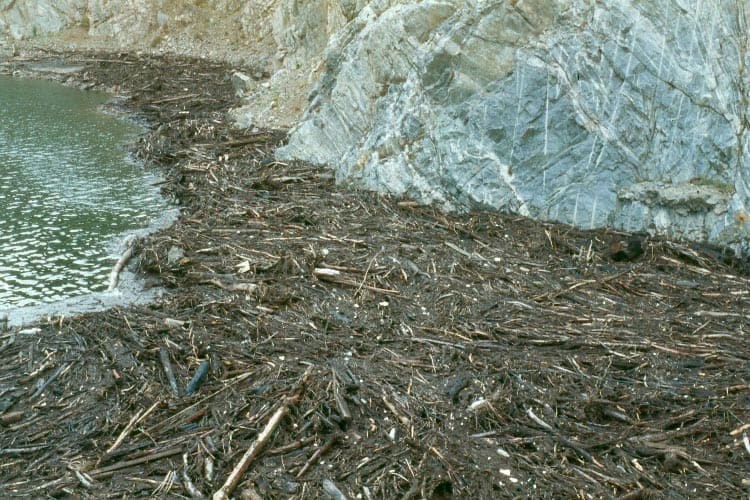
We’ve talked about the WUI quite a bit in terms of fuel treatments, and I know some of you want to talk about other fire effects. This story in the Denver Post this morning highlights tree thinning and prescribed burning around reservoirs.
Below are some excerpts:
— Top U.S. environmental officials Friday began a push to protect the nation’s federally run water-supply reservoirs against wildfires.
The fear is that worsening wildfires will trigger erosion that damages dams, canals and pipelines, and shrinks water storage, ultimately driving up water costs for ratepayers.
“Climate change is upon us, our ecosystems are changing and it’s up to us to work collaboratively,” Interior Secretary Sally Jewell told state, federal and local participants before signing a teamwork agreement at Horsetooth Reservoir, west of Fort Collins, an area where 11 wildfires since 2010 have unleashed sediment that threatens to clog water facilities.
Full funding has not been secured for work to protect 43 Bureau of Reclamation reservoirs in the West. But teamwork deals linking federal agencies, state foresters and water providers are enabling six startup tree-thinning and prescribed-burn projects in Arizona, California, Colorado, Idaho, Montana and Washington.
“When you’ve got a situation where there’s not enough money to go around, you have to pick your highest priorities,” Jewell said in an interview before the signing. “Obviously, protecting lives and property is important. But watersheds are really important. And I don’t think they’ve been on the radar to the same extent.”
Major wildfires in 1996 and 2002 burned 150,000 acres of Denver’s forested watershed and unleashed an estimated 1 million cubic yards of sediment into Strontia reservoir. Denver Water utility managers say they’ve spent $45 million trying to deal with wildfire erosion, including $17 million for dredging Strontia, a job still not done
I like this quote from Secretary Jewell:
Tree-thinning and prescribed burns around federal reservoirs — before anticipated wildfires hit — can reduce fires’ severity and minimize downstream damage from erosion, Jewell said. “If we get ahead of this, you will be spending less money.”
This statement by Vilsack is particularly interesting..
Changing how fire suppression is funded could help free funds for tree-thinning, prescribed fires and restoration work at federal reservoirs, he said without providing details. “This is about reducing the risk of contamination — sediment and ash getting into the water supply — which increases the cost of treating the water and the availability and the quality of water.”
I think folks tried to change how fire suppression if funded.. the FLAME Act, which didn’t work so well. I wonder what ideas the Secretary has?
If tree thinning is important, than why would you cut the budget from last year for doing this by 37%? Maybe USDI thinks differently and didn’t cut their as much?
For the Forest Service, one story would be that the broader Wildland Fire line item had to average out to 5% for sequestration. Another would be OMB doesn’t believe that thinning treatments work. It’s all very confusing.
For me.. if Secretary Jewell says thinning is important in words, then it should be translated into the most powerful policy document there is.. the budget, for all agencies involved. I guess reservoirs could be good to protect, towns not so much; but as a veteran of Colorado Roadless, I can tell you that some folks who don’t want people living in the woods are not really fond of reservoirs either.
Addendum.. there’s also an AP story in the Idaho Statesman here and here’s a press release.
Here’s some information on the Forest to Faucets partnership with Denver Water, which was spearheaded by folks in the Rocky Mountain Region of the Forest Service, pre-Vilsack.
Here’s a local view of debris that came down from a wildfire upstream, in the New Melones Reservoir, local to me.
https://maps.google.com/maps?hl=en&ll=38.129023,-120.380124&spn=0.001804,0.004128&t=h&z=19
In a state full of water wasters, the impacts of wildfires will hit hard, once we have more drought. Currently, agriculture is suffering the most, not getting the amounts of water they are used to getting. Some farmers are planting less water-intensive crops, and those veggie and fruit lovers despair over the lack of supply.
Those who depend upon the Colorado River for water will see the worst impacts. Shortages in the fall will begin to mount. I expect that car washes will be regulated and need to be “certified”, in the very near future. Same thing for businesses around salmon-bearing streams and rivers in the PNW. A water crisis is coming, and I doubt that we can react quickly enough to avoid drastic measures. Wildfires will be a huge part of that crisis, especially when we are letting wildfires turn into firestorms in the headwaters of major rivers.
All talk, and no do. But it does highlight that “forestry” has evolved from one about how it affects logging, to how it affects “urbanites.” Key change in perspective. what’s that word intellectuals use; paradigm…or epiphany.
Everytime I hear these calls for thinning in the Denver Water Board’s reservoirs, and frankly that means about every reservoir in the mountains of Colorado (I’m probably the only tourist who had his photo taken during vacation at the 12 mile long “Alva” tunnel which takes water from the west slope and dumps it on the east slope at Estes Park)…let’s see, what was I saying…oh yeah, everytime I think of the OSB mill that used to be a Kremmling. Perfect for thinning out small diameter lodgepole. While a bit of a distance, it had perfect rail connection to Denver and the front range. Has to be cheaper than piling and burning small diameter trees. why did it close again…oh yeah, enviro hyperbole about clean air and below cost timber sales.